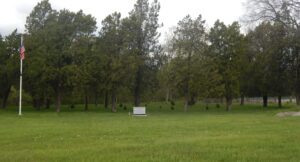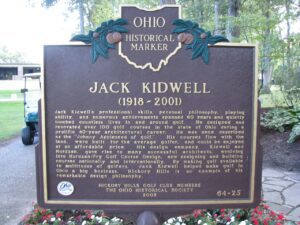, OH
Toledo State Hospital opened in January 1888 as the Toledo Asylum for the Insane. Originally located immediately south of this cemetery, the hospital was designed to function as a self-contained community for 650 people. Patients lived in large cottages, surrounded by a post office, church, library, male and female hospital, strong wards, bakery, and dining hall. People were admitted with mild to severe forms of mental illness, and a variety of other disabling conditions, including developmental, medical or neurological, as well as for addictions, injuries, and old age. Work became a form of treatment, with patients involved in construction, farming, laundry, and other jobs to help maintain the hospital. Patients could also participate in recreational activities from gardening to playing in the hospital band. The State Hospital became home for many, as hospitalization could last a lifetime, often spanning decades. (continued on other side)
, OH
Toledo State Hospital opened in January 1888 as the Toledo Asylum for the Insane. People were admitted with mild to severe forms of mental illness, and a variety of developmental, medical and neurological conditions, as well as for addictions, injuries, and old age. Originally built to house 650 people, by the 1950s its campus had grown to accommodate over 3,000. Growing access to new medications and treatments then began a gradual decline in patient population. Eventually, most of the buildings were razed, and much of the hospital’s property was transferred, later becoming the site of The Medical College of Ohio. This transfer included the two Toledo State Hospital cemeteries, with documented burials (as of 2009) totaling 1,994 persons. Toledo State Hospital New Cemetery was opened in 1922, when the Old Cemetery (1888-1922), located .5 miles to the northeast, reached capacity. (continued on other side)
, OH
Alexander Albert Drabik was born here, in a log cabin, on December 28, 1910 to John Drabik and Frances Lewandowski, Polish immigrants from Szymborze, Germany, now Poland. Alex, youngest son of 14 children, attended Door Street School. A meat cutter, he enlisted in the United States Army in October 1942. Drabik fought in the Ardennes, Central Europe and Rhineland Campaigns of World War II. He received a Purple Heart during the Battle of the Bulge. On March 7, 1945, Sergeant Drabik led 10 Company A soldiers of the 27th Armored Infantry Battalion of the 9th Armored Division across the Ludendorff railroad bridge from Remagen, Germany to the Rhine River east bank. (Continued on other side)
, OH
Garrett Augustus Morgan was an African American businessman and prolific inventor of devices that made people’s lives safer and more convenient. Born on March 4, 1877 in Claysville, the Black segregated section of Paris, Kentucky, Morgan migrated north first to Cincinnati and then Cleveland in 1895. He lived and worked in this house at 5204 Harlem Avenue. In 1906, Morgan started the G.A. Morgan Hair Refining Company to market the hair straightener he had invented. The following year he opened a sewing machine repair shop. In 1908, he and his wife Mary opened Morgan’s Cut Rate Ladies Clothing Store. (continued on other side)
, OH
Dedicated in 1939 in a ceremony that turned the gardens over to the city, the Cleveland Cultural Gardens are a unique memorial to world peace and the celebration of cultural diversity. The Gardens date to 1916 when the Shakespeare garden was built, and are a celebration of cultural identity in the form of natural landscaping, formal architectural elements, and commemorative sculpture. Consisting of 23 individual gardens, the Gardens reflect the diversity of cultures that shaped Cleveland and the nation. The Gardens pay tribute to the many philosophers, scientists, composers, and other great thinkers who have made significant and lasting contributions to civilization. More importantly, the Gardens are symbolic of the fact that through preservation of many different traditions, beliefs, and practices, we may be better able to accept and respect one another – that we may achieve a true and lasting peace through mutual understanding.
, OH
Self-educated golfer Jack Kidwell grew up in central Ohio. From 1937 until 1971, he owned and operated the Beacon Light Golf Course, where he started as a caddie. In 1943, he married Geraldine “Jerry” Kidwell, his wife of 57 years, and had four daughters, Sally, Shirley, Kathy, and Jody. Kidwell became a Class “A” golf course superintendent and earned life membership status as a Class “A”PGA professional. His peers selected Kidwell as president of the American Society of Golf Course Architects in 1980. A member of the Ohio Turf Grass Association, he was honored as Man of the Year in 1982. His accomplishments gained him induction into the Southern Ohio PGA Hall of Fame in 1977 and the Ohio Golf Association Hall of Fame in 1997.
, OH
Edward Drummond Libbey High School . Edward Drummond Libbey High School – “the castle on the hill” – opened in 1923 to serve the growing number of students in Toledo Public Schools. The school offered a curriculum of manual and academic training, reflecting a progressive movement during the late 19th and early 20th centuries to democratize education. Libbey High School was named for Edward D. Libbey (1854-1925), a local businessman, civic leader, and philanthropist who founded the Libbey Glass Company and Toledo Museum of Art. Libbey’s successful business ventures earned Toledo the nickname “The Glass Capital of the World.” Much of his fortune was spent on providing cultural and educational institutions that still serve the public as of 2018. (Continued on other side)
, OH
Born on September 21, 1918, golf course architect Jack Kidwell attended Columbus Central High School where he became the Ohio School State Golf Champion in 1937. Kidwell was the owner and operator of Beacon Light Golf Course from 1937-1971. He was inducted into both the Southern Ohio PGA Hall of Fame and the Ohio Golf Association Hall of Fame in 1997. He was the founding father of Hurdzan/Fry Golf Course Design and the inspirational leader to this day. Kidwell was a true giant of the golf industry and has been named the person having the most influence on golf in the state of Ohio over the past 200 years. He was married to his wife Geraldine “Jerry” Kidwell for 57 years and they had four daughters, Sally, Shirley, Kathy, and Jody. Jack Kidwell died on April 29, 2001.









